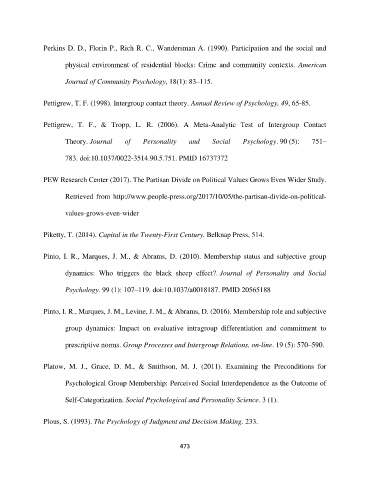Page 492 - Mike Ratner CC - WISR Complete Dissertation - v6
P. 492
Perkins D. D., Florin P., Rich R. C., Wandersman A. (1990). Participation and the social and
physical environment of residential blocks: Crime and community contexts. American
Journal of Community Psychology, 18(1): 83–115.
Pettigrew, T. F. (1998). Intergroup contact theory. Annual Review of Psychology, 49, 65-85.
Pettigrew, T. F., & Tropp, L. R. (2006). A Meta-Analytic Test of Intergroup Contact
Theory. Journal of Personality and Social Psychology. 90 (5): 751–
783. doi:10.1037/0022-3514.90.5.751. PMID 16737372
PEW Research Center (2017). The Partisan Divide on Political Values Grows Even Wider Study.
Retrieved from http://www.people-press.org/2017/10/05/the-partisan-divide-on-political-
values-grows-even-wider
Piketty, T. (2014). Capital in the Twenty-First Century. Belknap Press, 514.
Pinto, I. R., Marques, J. M., & Abrams, D. (2010). Membership status and subjective group
dynamics: Who triggers the black sheep effect?. Journal of Personality and Social
Psychology. 99 (1): 107–119. doi:10.1037/a0018187. PMID 20565188
Pinto, I. R., Marques, J. M., Levine, J. M., & Abrams, D. (2016). Membership role and subjective
group dynamics: Impact on evaluative intragroup differentiation and commitment to
prescriptive norms. Group Processes and Intergroup Relations, on-line. 19 (5): 570–590.
Platow, M. J., Grace, D. M., & Smithson, M. J. (2011). Examining the Preconditions for
Psychological Group Membership: Perceived Social Interdependence as the Outcome of
Self-Categorization. Social Psychological and Personality Science. 3 (1).
Plous, S. (1993). The Psychology of Judgment and Decision Making. 233.
473

